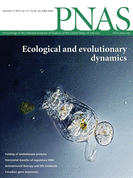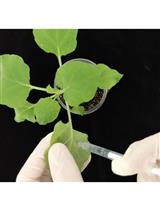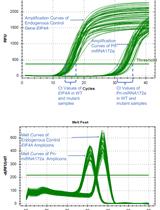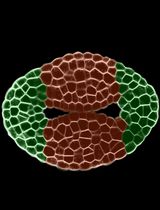- EN - English
- CN - 中文
Circular RT-PCR Assay Using Arabidopsis Samples
拟南芥样本的循环RT-PCR实验
发布: 2015年07月20日第5卷第14期 DOI: 10.21769/BioProtoc.1533 浏览次数: 17433
评审: Arsalan DaudiYuan ChenAnonymous reviewer(s)
Abstract
Post-transcriptional processing is critical for RNA biogenesis, in which conventional functional RNA transcripts are generated, such as messenger RNAs (mRNAs), transfer RNAs (tRNAs) and ribosomal RNAs (rRNAs) for translation as well as emerging non-coding RNAs with known or unknown regulatory functions. To determine the precise termini of an RNA molecule during or after processing, the primer extension and Rapid Amplification of cDNA Ends (RACE) methods have been routinely utilized for the precise mapping of 5’ or 3’ ends. Different from these assays, which are designed to detect only one end of a specific target RNA at a time, circular Reverse Transcription-Polymerase Chain Reaction (cRT-PCR) is able to simultaneously determine both the 5’ and 3’ ends of the target RNA. In Arabidopsis thaliana, cRT-PCR has been wildly applied to identify both the 5’ and 3’ extremities of the ribosomal RNA precursors, or to assess the length or post-transcriptional extensions at the 3’ end of a matured mRNA. In this protocol, we summarize and present a detailed procedure of the cRT-PCR assay in Arabidopsis thaliana, which is also successfully used in our previously published work (Hang et al., 2014).
Keywords: Circular RT-PCR (循环检测)Materials and Reagents
- Arabidopsis thaliana 14-day-old seedlings
- M13F: 5′-TGTAAAACGACGGCCAGT-3′ and M13R: 5’-CAGGAAACAGCTATGAC-3’
- TRNzol Reagent (TIANGEN®, catalog number: DP40502 )
- Dynabeads® mRNA Purification Kit (Life Technologies, catalog number: 61006 )
- FirstChoice® RLM-RACE Kit (Life Technologies, catalog number: AM1700 )
- RNA 5’ Polyphosphatase (Epicentre, catalog number: RP8092H )
- T4 RNA Ligase 1 (New England Biolabs, catalog number: M0204S )
- T4 RNA Ligase Reaction Buffer (New England Biolabs, catalog number: B0216L )
- Adenosine 5'-Triphosphate (New England Biolabs, catalog number: P0756S )
- RNasin® Plus RNase Inhibitor (Promega Corporation, catalog number: N2615 )
- Glycogen (RNA grade) (Thermo Fisher Scientific, catalog number: R0551 )
- TransScript® II First-Strand cDNA Synthesis SuperMix (TransGen Biotech, catalog number: AH301 )
- TaKaRa ExTaq® DNA Polymerase (Takara Bio Company, catalog number: RR001B )
- pEASY® -T1 Cloning Kit (TransGen Biotech, catalog number: CT10102 )
- Trans2K® Plus II DNA Marker (TransGen Biotech, catalog number: BM121-01 )
- Diethyl pyrocarbonate/DEPC (Sigma-Aldrich, catalog number: D5758 )
- TIANgel Midi Purification Kit (TransGen Biotech, catalog number: DP209 )
- UltraPureTM Agarose (Life Technologies, catalog number: 75510019 )
- DEPC-treated deionized water (see Recipes)
- 3 M sodium acetate (see Recipes)
- 70%, 100% ethanol (see Recipes)
- 50x TAE buffer (see Recipes)
Equipment
- MaxyClear Microtubes (1.5 ml) (Corning Incorporated, Axygen®, catalog number: MCT150C )
- NanoDropTM 1000 Spectrophotometer (Thermo Fisher Scientific, catalog number: ND-1000 )
- Thermomixer comfort (Eppendorf, catalog number: 5362.000.019 )
- Eppendorf Centrifuge (Eppendorf, catalog number: 5417R )
- PCR system (Eastwin Life Science, catalog number: EDC-810 )
- Other standard laboratory equipment
Procedure
文章信息
版权信息
© 2015 The Authors; exclusive licensee Bio-protocol LLC.
如何引用
Hang, R., Deng, X., Liu, C., Mo, B. and Cao, X. (2015). Circular RT-PCR Assay Using Arabidopsis Samples. Bio-protocol 5(14): e1533. DOI: 10.21769/BioProtoc.1533.
分类
植物科学 > 植物分子生物学 > RNA > 转录
分子生物学 > RNA > qRT-PCR
分子生物学 > DNA > PCR
您对这篇实验方法有问题吗?
在此处发布您的问题,我们将邀请本文作者来回答。同时,我们会将您的问题发布到Bio-protocol Exchange,以便寻求社区成员的帮助。
Share
Bluesky
X
Copy link














